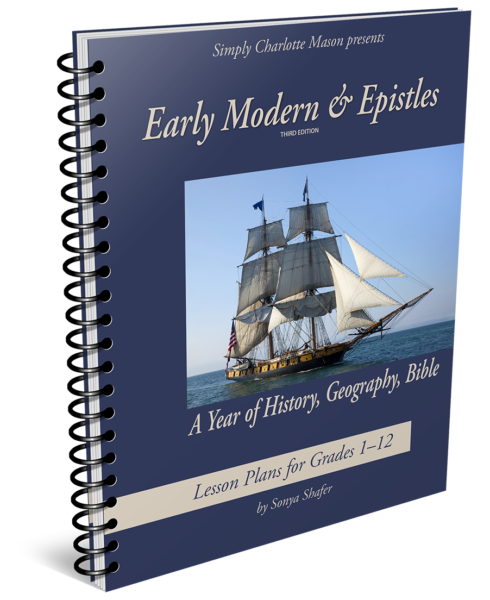Free shipping on USA orders over $129!
Early Modern & Epistles Links and Tips

The links below are related to our book Early Modern & Epistles. This study combines all your students, grades 1–12, for a full year of Bible, history, and geography. Be sure to check back here from time to time. We will be adding new and updated resources related to the book as we get them. If you have some resources that you’d like to recommend, let us know!
Complete Year’s Book List
See the complete list of books recommended in this study by grade level and with recommendations for where to find each book.
Printable Maps
These maps are available for you to print and use with the lesson plans.
One-Volume edition of America: The Last Best Hope
Early Modern & Epistles uses America: The Last Best Hope for high school students. We schedule the Three-Volume edition. A One-Volume edition, copyright 2019, is also available. The One-Volume edition
- Omits Volume 1, chapters 1 and 2
- Contains Volume 1, chapters 3 and following, and Volume 2, all chapters
- Contains a greatly condensed version of Volume 3, paring the original 275 pages down to only 54 pages, as the Epilogue
More on Early Modern (c. 1550–1850)
Dover Coloring Books
The pictures in these coloring books are quite detailed with a brief explanation on each one. Older students might want to use colored pencils or even watercolor paints.
- Colonial and Early American Fashions
- Daniel Boone
- Early American Crafts and Occupations
- Early American Trades
- Empire Fashions
- Everyday Dress of the American Colonial Period
- French Baroque and Rococo Fashions
- George Washington
- Heroes and Heroines of the American Revolution
- Lewis and Clark Expedition
- Olde New York
- Story of the Alamo
- Tudor and Elizabethan Fashions
Geography Book
Another great geography book for this time period would be Stowaway by Karen Hesse. It reads like the journal of a young boy who stows away on Captain Cook’s first voyage.
Shakespeare REsources
Absolute Shakespeare is a great source for his plays, sonnets, poems, quotes, biography, film adaptations, and information about the Globe theatre.
Shakespeare Online has some interesting trivia and historical facts.
Newton’s Writings
The Newton Project allows you to see Isaac Newton’s writings as he originally wrote them.
Napoleon
The Wikipedia article on Napoleon has many great images and lots of information that you may find helpful.
Hands-on Project Ideas
Many hands-on activities are available if you would like to supplement your study of Early Modern times. Here are some suggestions (in random order) with links to details.
American History
Oiled Paper Windows
To experience the kind of windows that colonists used in their houses, rub some salad oil into a piece of paper. Hold it up to the sun to see how much light gets through. You could also test how well those windows kept out the wind by blowing a fan on the oiled paper. Test their rain-resistance by spraying some water onto the paper.
Rag Rug
Colonists used every scrap of fabric. One way they “recycled” fabric was by making rag rugs. You can easily create your own simple rag rug by tying strips of material end to end, then twist the rag “rope” to give it more strength. Coil the “rope” into a circle and sew the strands together to keep them in place.If you want to dig deeper into this craft, take a look at The Craft of Hand-made Rugs by Amy Hicks, written in 1914.And if you know how to crochet, this rag rug tutorial will put that skill to use.
Colonial Toys and Games
Children in the Early Modern times usually played with jump ropes, kites, marbles, and rolling hoops. They also played Leapfrog, Hopscotch, and Blindman’s Bluff. You might want to take a day to play these games and toys. If your children don’t know how to play marbles, try this How to Play Marbles explanation. These games of pioneer children explain about hoop rolling and many other games and toys. Keep in mind that though the pioneer children played these, they most likely learned them from their parents who lived during Early Modern times. So many of the games should be similar.
Gingerbread Letters
A Colonial child would sometimes receive a freshly baked gingerbread cookie in the form of a letter he had just learned. Here’s a recipe that recommends you use a butter knife to cut out the letters.
Make Butter
Increase your children’s appreciation for butter and build their muscles at the same time. Here’s how: Pour a pint of cream into a clean jar and make sure the lid is tightly closed. Shake the jar vigorously until butter forms (probably 15-20 minutes). Pour off the liquid. Try your butter on a piece of bread.
Stitch a Sampler
Here are some historic samplers that might give you an idea of what sort of work was done in Early Modern times. You may want to help your child stitch a sampler, using cross-stitch or several kinds of embroidery stitches.
World History
Thanks to Rebekah A. for these recommendations for hands-on activities from Early Modern world history (1550–1850).
- Put together a Shakespeare’s Globe Theatre paper model.
- Make some finger puppets to act out one of Shakespeare’s plays. You can also purchase a set.
- The Dutch people cook with many fragrant spices. Find a recipe online for Dutch Spice Cake and/or Speculaas. These products may even be on your supermarket shelves! YUM
- Bake and decorate a cake to look like the Great Wall of China.
- Create Ming Dynasty pottery using a plain white plate and blue ceramic paint.
- Search for a tutorial on how to make a guillotine.
- Use a flashlight and Morse Code at night in the backyard to send a message to your siblings.
